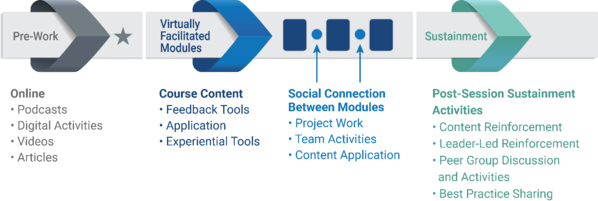The Shift to Virtual Learning: Scalable Training for Modern Workforces
- Sales Performance and Training
- Author: Eagles Flight Admin
- June 29, 2021

Want To Print This Webpage Or Read It Later? Download A PDF Version Here!
Introduction
We’re in the middle of a work revolution and the path to organizational success is more complex than ever. Organizations face challenges ranging from rapidly advancing technology to increased competition, to radical shifts in customer expectations, which are forcing organizations to rethink their approach to talent management and the skills their employees need.
For survival, and even competitive advantage, organizations of every size and in every industry must upgrade employee knowledge and skills to meet the challenges of a workplace that is changing and they must do it fast. A 2018 World Economic Forum study estimates that by 2022, no less than 54 percent of all employees will require significant reskilling and upskilling, primarily in areas such as analytical thinking, innovation, and skills that enable employees to keep pace with digital transformation.
Unfortunately organizations have largely been unable to keep up with the rapid pace of change. Even those with extensive organizational training and development plans and budgets struggle to adequately adapt given the ruthless pace and scale of change. As a result, upskilling has faltered and the gap between the skills needed to succeed, and the actual bench strength of an organization’s workforce has widened.
The question then is, how do you upskill your workforce quickly and effectively? In this guide we will explore how to do just that by building out a virtual learning strategy that drives organizational success.
Chapter 1
Workplace Trends Influencing The Shift To Virtual Learning
Ongoing shifts in the nature of work and how it is performed require new ways of approaching employee learning and development. In fact, organizations and employees alike recognize that training is not only essential for individual growth but also necessary for keeping up with the changing world we live in. A Deloitte study found that 67 percent of employees believe they must continuously reskill themselves just to stay in their current career.
Fortunately, many organizations understand the benefit and need to upskill their employees and are looking to virtual learning as a way to do that in addition to traditional methods and in-person training. In a 2020 report by LinkedIn, it was found that 53 percent of L&D professionals surveyed expect to spend more on online learning globally this year. Some of the specific workplace trends that are driving the increase in virtual learning solutions include:
Remote Work and Dispersed Regional Offices
While remote work has been on the rise for years, COVID-19 dramatically and irreversibly changed where and how we work. Unless it was absolutely necessary to be on the frontline, overnight employees started to work from home. Rather than remote work being the exception, it became the new normal. For many leaders it may have acted as a living case study, showing them that it is possible for their employees to be just as, if not more, productive outside of the office. As such, many expect this trend to stick around after COVID-19 dissipates now that the workforce has first-hand experience working remotely.
Remote work and regional offices demand organizational structures to flex with the needs of the workforce through advancements in technology that enable mobility and flexibility. To capitalize on these benefits and stay competitive, many companies are putting a greater focus on organizational design and restructuring into networks of teams. Rather than staying in departmental silos, these teams are more project-oriented and come together often on a temporary basis to work on specific tasks. These new structures require updated virtual training programs to accommodate leadership development, performance management, and skills training in an evolving corporate environment.

Employee Preferences
A desire to learn and grow is nothing new, but research points to a shift in how and when employees want to learn. For example, the 2018 LinkedIn Workplace Learning Report found that although 94 percent of employees said they would stay employed longer with a company that invested in their career, they want a greater say in how, when, and where they learn. Of the employees surveyed in the study:
- 68 percent said they enjoy learning at work
- 58 percent preferred to learn at their own pace
- 49 percent want just-in-time learning when they need it
To address employee learning needs and preferences, you’ll need to look beyond traditional training and incorporate other training methodologies and delivery options. Experiential training is a great example of this as it’s an interactive methodology that allows learners to learn by doing, not just watching, listening, or reading, which appeals to many types of learners. Online learning that is self-directed is also highly valued and desired by employees as it grants authority to the individual over when and where they learn the required content.
Rapid Changes
Most of the time, the future unfolds gently. However, today we’re faced with a world that changes seemingly overnight and puts all previous business assumptions in question or out of date. For some organizations this has forced them to pivot the way they work, or in some instances, their whole business, to meet today’s reality.
According to the IBM Institute for Business Value, 60 percent of executives globally confirmed they are struggling to keep their workforce current and relevant. Employees and leaders alike require a new set of competencies and need to obtain them quickly in order to be successful in their roles. To accomplish this, online learning is an ideal option for training large groups of employees, very quickly. As everything is done virtually, there is no need to roll out the training in small groups in a given location. No matter where employees are located, online learning allows them to join in from wherever they are to obtain the new skills they need.
Employee Engagement
No matter if your employees are in the office or working from home, the opportunity for learning and development remains a top driver of employee engagement, as proven in numerous research studies. For example, a Udemy Study found that 80 percent of employees said that learning new skills would make them more engaged at work. In another example, a business author and researcher conducted a regression analysis of over three million employee engagement surveys and found that learning and development drives employee engagement, particularly when the learning is aligned to employee aspirations and supported by leadership.
Younger Generations
There are currently four generations in the workforce: baby boomers, Generation X, millennials, and the first of Generation Z. The oldest millennials, born between 1981 and 1995, are now in their late 30s and have begun to move into key positions of leadership. While Generation Z, those born between 1996 and 2010, are entering the workforce as digital natives. As a result of this dramatic change in workplace demographics, learning and development preferences and expectations have also changed.
In a Gallup survey, 59 percent of millennials said opportunities to learn and grow were extremely important to them when applying for a job. By offering learning and development opportunities that appeal to all generations now in the workplace, companies will be on better footing to attract and retain the very best. For example, millennials tend to be attracted to learning and development experiences that:
- Incorporate digital technology
- Build upon their leadership potential
- Include interactive, social learning experiences
Importance Of Collaboration
Employees today spend an average of 14% of their workweek communicating and collaborating internally. They are also on twice as many teams as they were five years ago. Regardless if this is due to a rise in remote work, organizational complexity, or globalization, the need for effective collaboration skills and tools has never been greater.
In fact, a study conducted by McKinsey found that by implementing social technologies, companies have an opportunity to raise the productivity of high-skill knowledge workers, including managers and professionals, by 20 to 25 percent. But implementing new technology will not be enough. Companies must remember the people who will be using it in their day-to-day lives. These members of your workforce will greatly benefit from collaboration and teamwork training (whether delivered in-class or virtually) that teaches them how to communicate effectively, share resources, remain focused on a unanimous goal and define subgroups.

Chapter 2
Why Do Virtual Learning Programs Fail?
Benjamin Franklin once said, “An investment in knowledge always pays the best interest.” Yet determining what the exact knowledge needed is, researching providers, gaining buy-in and support, and integrating it into the workload can feel like too great an investment for some, especially when times are tough.
Ultimately, this can be a costly mistake, as studies have found that those who make the investment in truly effective training and development experience:
- 218% higher income per employee
- 24% higher profit margin
- Reduced turnover and greater loyalty
- Improved engagement (Approximately $500 billion is lost every year due to employee disengagement)
So, whether your reason for implementing virtual learning is to develop specific competencies within your workforce, or to support a strategic organizational initiative, the goal is for it to succeed so that your organization can experience both the tangible and intangible benefits. That begs the question then, why do so many virtual learning programs fail? Below we have listed five common pitfalls so that you can actively work to avoid them when building out your own virtual learning and development solution.
No Explanation on the Purpose or Benefit
It’s hard to care about something you don’t understand, and yet, employees often find themselves pulled into an online learning session with little to no explanation of its purpose. Employees today crave a deeper understanding so they can identify the purpose of training and see how it impacts their overall success at work. In light of this reality, it is important to ensure your virtual training program is set up to introduce the purpose of the training beforehand. Doing so will make it infinitely easier to engage employees and leaders as the training progresses. To do this effectively means creating a training initiative that is directly applicable and practical in employees’ day-to-day lives.
Focuses Only On Knowledge Transfer
Many online training and development programs focus solely on knowledge transfer. Providing knowledge is an intellectual activity, with the goal of informing participants of how or why to do something. Many people who have participated in virtual training have experienced stilted presentations, passive videos narrated by a mechanical voice, overly academic articles, and endless quizzing. What’s worse than being boring and stilted, is the fact that this kind of online training is just not effective for the majority of the population. That’s because these passive eLearning programs do little to change participant behavior long-term. Employees may learn about valuable new skills through passive forms of training, but passive consumption of knowledge doesn’t guarantee application.
On the other hand, virtual learning programs that have participants personally and actively involved in their own learning, encourage an intellectual understanding of the new behaviors to develop quickly. Once this understanding has started to occur, the virtual training must shift information to competence to solidify understanding and build conviction to take the knowledge learned and actually use it. By providing time in the safety of the virtual classroom to practice the new skills and tools, ask questions, and work with colleagues, employees will emerge both competent and confident.
Lacks Live Learning and Active Participation
Passive, self-guided learning where participants listen, watch, or read information, has a few use cases it lends itself decently to, such as technical training. Unfortunately, it typically has very low retention rates, as most people only remember about 10 percent of what they read or hear. Ultimately, this puts your online learning investment at risk.
A better option of virtual learning is known as synchronous training, which “occurs when learners and instructors are interacting in real-time, typically through delivery platforms, remote labs, distance learning technologies such as video conferencing and chat, or collaboration and social learning technologies.” When participants have the opportunity to interact with the facilitator and their colleagues the collective learning increases in a way that cannot happen through passive, self-guided learning. Not to mention, a skilled facilitator can build conviction in participants that it is beneficial to change behavior and adopt the new knowledge, skills, and tools by using language and examples that resonate directly with the participants.
No Opportunity to Practice New Skills and Direction on How to Use Them On the Job
Virtual learning programs that don’t relate to the challenges employees face every day at work do not set participants up to successfully use their new knowledge on the job. For example, understanding the importance of active listening as a communication skill is not the same as applying that skill for oneself in a situation that mimics one similar to the workplace. When online training for employees does not provide an opportunity to practice new skills in real-time with the support of an experienced facilitator who can coach them in a safe environment, participants may be reluctant to use the skills at work.
Chapter 3
Why Do Virtual Learning Programs Fail?
In the 2020 Workplace Learning Report, learning and development professionals named learner engagement one of their main challenges. With the shift towards remote work, increased workloads, and short attention spans, this may come as no surprise.
To solve this challenge, learning and development professionals must put greater emphasis on creating a robust, relevant, and immersive learner journey. From the moment pre-work is sent out to participants, to the weeks after training has occurred and everyone has returned to their realities, every experience your learners have must intentionally and strategically encourage engagement. Whatever this journey ends up looking like, it should be heavily influenced by the unique preferences of your learners. Fortunately, a study by LinkedIn found that talent development professionals are already changing the way they deliver training to better meet the needs of all learners. They are looking at increasing the usage of social, mobile, leader involvement, and self-directed learning opportunities to increase engagement, particularly with Millennial and Gen Z workers.

As you search for a virtual training company to work with, proactively look for information on the following four stages of an effective training program. If the provider in question has plans to engage your learners at each stage, then you are one step closer to finding the right partner for your needs and your audience.

Pre-Work and Self-Guided Learning
Unfortunately, pre-work gets a bad reputation. When treated as a “check the box” activity, pre-work can quickly fall flat in the eyes of the participants who have to complete it, learning and development professionals who have to mandate it, and leaders who have to make room for it on a busy day. Remember, first impressions matter and what you decide to send out as pre-work will inform a participant’s opinion of the rest of the training program, so make this count. The activities selected to complete before the live training begins should be relevant, relatively quick to complete and provide learners with the information they need to feel prepared. This is an invaluable opportunity to set the tone of the virtual training to come and get participants excited for what you have planned.

Training Modules or Sessions
When training modules are created to inspire conviction, they effectively change the attitudes, skills, and behaviors needed to unleash every employee’s potential. Employees often learn best through interactive, experiential learning modules that teach and coach them how to actually use the knowledge provided in practice. Experiential learning is an exceptional way to ensure lasting behavior change because it combines immersive activities that mimic real-world challenges with a targeted debrief that connects the lessons learned with the reality of the workplace. It allows participants to learn by doing and not by just listening, reading, or watching. Because they have personally experienced the lessons, new competencies are developed, more information is retained, and individuals are likely to return to work ready and enthusiastic to apply their new knowledge.
Post-Module Assignments
To avoid virtual learning programs from becoming six or more hours long, it is best the training be split into modules with post-module assignments in-between. This makes for a better learner experience, allows participants to practice their new knowledge and skills between modules, and access support from colleagues or their facilitator if they run into challenges. Like the activities required during pre-work, post-module assignments should be relevant and not overly time-intensive. They should reinforce the knowledge provided in the previous module, while also providing information required for the next module that will make sure they have the best experience possible.

Sustainment
There are many things working against the application of new behaviors: old habits, time pressure, peer pressure, lack of support from a supervisor, lack of personal confidence, and just plain forgetting what was learned. This is where sustainment activities show their value. To create lasting change, new skills and behaviors must be retained, coached, reinforced, and measured over time. During this portion of the learner journey, the goal is to remind participants what has been taught and provide any additional tools or resources that would help them back on-the-job.
Chapter 4
Popular Virtual Learning Topics
In order to adapt to a changing world and meet organizational needs, companies today are investing in virtual learning solutions for the following topics:
Leadership Training
The need for great business leaders has arguably never been greater. In order to rise to the challenges, leaders today at all levels need new and improved knowledge, skills, and tools to ensure their own success, along with that of their team and organization. An ideal way to provide this quickly but effectively is with online leadership training. As part of a greater leadership development strategy, virtual learning for leaders will allow you to tackle important challenges and areas such as change management, empowerment, strategy and execution, coaching, and performance management.
Safety Training
In order to lower injury rates, boost productivity, improve morale, and most importantly save lives, it will take more than compliance and technical training. While these training programs are essential, organizations may benefit from taking a step further by creating a personal commitment to safety in every employee and leader. By creating commitment and ownership to their personal safety and the safety of others, even as regulations and safety standards change, real results and behavior change can occur. This can be done with the help of online safety training programs for employees and leaders at all levels and as part of a great learning and development initiative that blends in-class and virtual learning.
Sales Training
In many cases, salespeople would much rather be out selling than in training, so you must provide a good reason for them to be fully present during online sales training. There’s no better way to do that than with experiential activities, videos, case studies, breakout sessions, and a world-class facilitator to facilitate relevant discussions. By using proven learning methodologies in the online classroom, you will be far more likely to engage sales teams, build confidence and competence within individuals, and prepare employees for future growth and change.
Skills and Competency Training
Technical skills vary from function to function, while there are skills that every employee requires, no matter their role or level in the organization. In fact, a survey of L&D professionals and executive leaders named training for soft skills as the leading priority for employee development. To do this both efficiently and effectively, many organizations look to virtual learning to fill the need. Whether the need for training is better communication, accountability, collaboration and teamwork, innovation, or conflict resolution, online skills training can work, you just need to be sure your solution of choice is interactive and offers plenty of opportunities for practice.
Customer Service Training
Given that a moderate improvement in the customer experience would impact the revenue of a typical $1 billion company by an average of $775 million over three years, companies today are increasingly committed to moving beyond customer service to customer centricity. In order to do so successfully, training will be critical. From online customer service training for those in customer-facing positions to company-wide customer-centricity training, the goal will be to give employees and leaders the skills and tools they need to put the customer experience at the heart of all their decisions and actions.
Diversity and Inclusion Training
72% of surveyed organizations today are putting a conscious focus on creating a culture of diversity and inclusion, which requires intentionally changing the mindset and behavior of employees at every level of the organization. By doing so, organizations can create an environment where everyone walks in every day feeling they truly belong there and can be their authentic selves. To make this a reality, online diversity and inclusion training is one part of a greater strategy. Done well, it can provide knowledge, encourage conversations, and create connections, which are all essential to building a truly inclusive workplace.
Many of these popular virtual learning topics — leadership, safety, sales, customer service, skills, and diversity — can be addressed through a virtual learning solution that utilizes the power of experiential learning to build conviction and create real behavior change.
Chapter 5
What to Look for In a Virtual Training and Development Partner
One of the most important factors to consider when selecting a partner is whether their capabilities align with your business goals. If a potential partner doesn’t have the right level of experience, has never operated in your field before, or strictly delivers off-the-shelf products that do not match your needs, it’s better to know before you make an investment. Here are the key things to look for when choosing a virtual training partner.
Partnership-Oriented
An effective virtual learning program or initiative should be designed with you, not for you. The needs of your learners and business are unique, and so to make it as relevant as possible it is essential to prioritize working with a provider who is willing to work in partnership with you and your team. By doing this, your provider can deliver against your reality and specific needs, as to create real behavior change.
Proven Track Record
When hiring an external partner to provide a virtual learning solution, it is important to know why you should trust them with your learners, your reputation, and your organization’s investment. So although they may not be able to disclose client names for privacy reasons, your partner of choice should provide examples of their work and speak to the work they have done with their clients, even without mentioning a specific name.
Consultation Services and Rollout Support
Implementing virtual learning can be exciting, though it is imperative to your success that you do not rush into it. Time taken upfront to understand key challenges, determine the competencies or behaviors that need immediate attention, and get alignment on the strategic direction, can multiply the impact of your efforts. It is in the best interest of your provider to provide you with the tools and necessary support to accomplish these things, as it will help them craft your perfect solution.
Proven Methodology
Methodology has a significant impact on the success of virtual learning. Many eLearning providers tend to simply provide knowledge by having learners read, watch, or listen, thereby turning training into a purely intellectual activity. While important, other methodologies, such as experiential learning, will go beyond knowledge transfer to build conviction in learners to change their behavior. This is done through interactive and immersive activities that mimic the challenges of the real world while being masked by fun and captivating metaphors. This makes the learning experience fun, engaging, and with the help of a debrief to tie it all together, relevant for everyday application.
Customization
Customizing training content, whether delivered in-class or virtually, builds the relevance necessary to engage your audience and inspire them to change their behaviors. Learners will often recognize the time and effort put into virtual training that looks, feels, and sounds like their organization. Therefore, the ideal virtual learning provider will encourage rebranding the materials or adding internal language to the discussion.
Chapter 6
Implementing Virtual Learning That Truly Changes Behavior
Maximizing the success of virtual learning takes more than logging into an online classroom and hoping employees know how to apply the knowledge to change their behavior and improve results. Rather it requires thorough preparation, alignment, and a trusted training partner who can support your needs from beginning to end. At Eagle’s Flight, we understand how to design and deliver training programs that change employees’ hearts and minds, resulting in lasting behavior change. After 30+ years of using experiential learning in the classroom, we have brought the methodology to the virtual classroom with the help of Howspace and their AI-powered learning platform. The result is a virtual learning solution that helps individuals make direct connections between their actions and their desired performance outcomes, resulting in better performance.
Table of Contents
Want To Print This Webpage Or Read It Later? Download A PDF Version Here!
Simply fill out this form to receive a PDF version of our guide.

Related Topics
The Growth Mindset Advantage: 5 Skills for the Future-Fit Professional
Discover the profound impact of repetition for effective communication in our latest blog post. Understand how repeating key messages enhances comprehension and clarity, and triggers action within organizations, ultimately leading to improved stakeholder relationships and profits.
The Critical Role of Leaders in Developing Talent
Discover the strategies and approaches that empower leaders to cultivate a culture of continuous learning and development, driving innovation and excellence at every level.
The Power of Repetition: Why Effective Communication Relies on Saying Things More Than Once
Discover the profound impact of repetition for effective communication in our latest blog post. Understand how repeating key messages enhances comprehension and clarity, and triggers action within organizations, ultimately leading to improved stakeholder relationships and profits.



